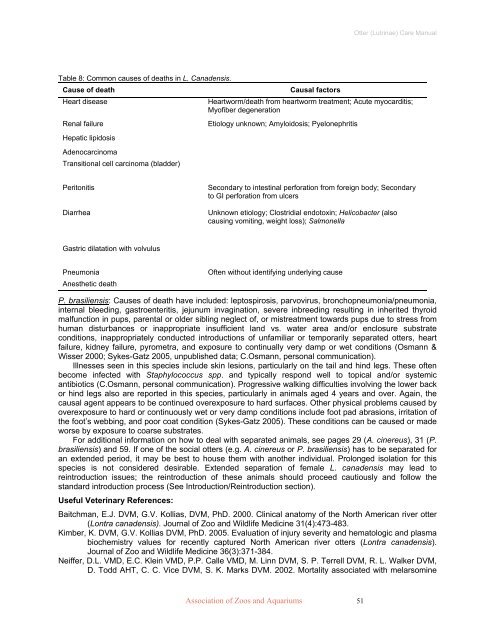Otter (Lutrinae) Care Manual - Association of Zoos and Aquariums
Otter (Lutrinae) Care Manual - Association of Zoos and Aquariums
Otter (Lutrinae) Care Manual - Association of Zoos and Aquariums
You also want an ePaper? Increase the reach of your titles
YUMPU automatically turns print PDFs into web optimized ePapers that Google loves.
Table 8: Common causes <strong>of</strong> deaths in L. Canadensis.<br />
Cause <strong>of</strong> death Causal factors<br />
<strong>Association</strong> <strong>of</strong> <strong>Zoos</strong> <strong>and</strong> <strong>Aquariums</strong> 51<br />
<strong>Otter</strong> (<strong>Lutrinae</strong>) <strong>Care</strong> <strong>Manual</strong><br />
Heart disease Heartworm/death from heartworm treatment; Acute myocarditis;<br />
My<strong>of</strong>iber degeneration<br />
Renal failure Etiology unknown; Amyloidosis; Pyelonephritis<br />
Hepatic lipidosis<br />
Adenocarcinoma<br />
Transitional cell carcinoma (bladder)<br />
Peritonitis Secondary to intestinal perforation from foreign body; Secondary<br />
to GI perforation from ulcers<br />
Diarrhea Unknown etiology; Clostridial endotoxin; Helicobacter (also<br />
causing vomiting, weight loss); Salmonella<br />
Gastric dilatation with volvulus<br />
Pneumonia Often without identifying underlying cause<br />
Anesthetic death<br />
P. brasiliensis: Causes <strong>of</strong> death have included: leptospirosis, parvovirus, bronchopneumonia/pneumonia,<br />
internal bleeding, gastroenteritis, jejunum invagination, severe inbreeding resulting in inherited thyroid<br />
malfunction in pups, parental or older sibling neglect <strong>of</strong>, or mistreatment towards pups due to stress from<br />
human disturbances or inappropriate insufficient l<strong>and</strong> vs. water area <strong>and</strong>/or enclosure substrate<br />
conditions, inappropriately conducted introductions <strong>of</strong> unfamiliar or temporarily separated otters, heart<br />
failure, kidney failure, pyrometra, <strong>and</strong> exposure to continually very damp or wet conditions (Osmann &<br />
Wisser 2000; Sykes-Gatz 2005, unpublished data; C.Osmann, personal communication).<br />
Illnesses seen in this species include skin lesions, particularly on the tail <strong>and</strong> hind legs. These <strong>of</strong>ten<br />
become infected with Staphylococcus spp. <strong>and</strong> typically respond well to topical <strong>and</strong>/or systemic<br />
antibiotics (C.Osmann, personal communication). Progressive walking difficulties involving the lower back<br />
or hind legs also are reported in this species, particularly in animals aged 4 years <strong>and</strong> over. Again, the<br />
causal agent appears to be continued overexposure to hard surfaces. Other physical problems caused by<br />
overexposure to hard or continuously wet or very damp conditions include foot pad abrasions, irritation <strong>of</strong><br />
the foot’s webbing, <strong>and</strong> poor coat condition (Sykes-Gatz 2005). These conditions can be caused or made<br />
worse by exposure to coarse substrates.<br />
For additional information on how to deal with separated animals, see pages 29 (A. cinereus), 31 (P.<br />
brasiliensis) <strong>and</strong> 59. If one <strong>of</strong> the social otters (e.g. A. cinereus or P. brasiliensis) has to be separated for<br />
an extended period, it may be best to house them with another individual. Prolonged isolation for this<br />
species is not considered desirable. Extended separation <strong>of</strong> female L. canadensis may lead to<br />
reintroduction issues; the reintroduction <strong>of</strong> these animals should proceed cautiously <strong>and</strong> follow the<br />
st<strong>and</strong>ard introduction process (See Introduction/Reintroduction section).<br />
Useful Veterinary References:<br />
Baitchman, E.J. DVM, G.V. Kollias, DVM, PhD. 2000. Clinical anatomy <strong>of</strong> the North American river otter<br />
(Lontra canadensis). Journal <strong>of</strong> Zoo <strong>and</strong> Wildlife Medicine 31(4):473-483.<br />
Kimber, K. DVM, G.V. Kollias DVM, PhD. 2005. Evaluation <strong>of</strong> injury severity <strong>and</strong> hematologic <strong>and</strong> plasma<br />
biochemistry values for recently captured North American river otters (Lontra canadensis).<br />
Journal <strong>of</strong> Zoo <strong>and</strong> Wildlife Medicine 36(3):371-384.<br />
Neiffer, D.L. VMD, E.C. Klein VMD, P.P. Calle VMD, M. Linn DVM, S. P. Terrell DVM, R. L. Walker DVM,<br />
D. Todd AHT, C. C. Vice DVM, S. K. Marks DVM. 2002. Mortality associated with melarsomine









